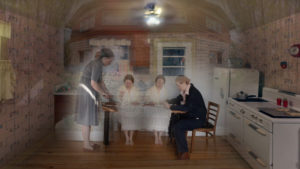In this era of information overkill, one may absorb endless volumes, yet the impact of each tale remains a solitary and private event, each word soaking in, one at a time, to imprint its distinctive mark on one’s being.
A somber family legend took root in the mind of artist Teresa Braun, who has created for her exhibition, “Who From Below,” an immersive video trilogy that conveys multilayered imagery about familial rituals and mortality. Braun was raised on her grandparents’ farm in a Mennonite community in Canada and absorbed its ascetic influence into her perspective on the world. The Mennonites are a quiet and peaceful denomination, emphasizing modest attire and avoidance of technology and worldly sins. Some ethno-religious branches emphasize Germanic roots, and may speak German.
“Who From Below,” uses a three part, single-channel video to evoke the story, passed down by generations, of three sisters who were buried under a tree on the farm, initiating a family cemetery. When Braun’s father refurbished the grounds, the young women’s graves were never found; his hypothesis was that they had been “taken up into the root system of the tree.” This haunting and metaphysical proposition is further explored in Braun’s fictive booklet, De Schwoate Bruhne von Eigengrund (The Blacks and Browns of Our Own Ground) (2015), a five-part tale containing metaphorical stories about the women, and their assimilation into living cottonwood trees.

Teresa Braun, When I am Laid in Earth, 2016, ©Teresa Braun, courtesy of the artist and Catharine Clark Gallery, San Francisco
Sweeping operatic compositions by 17th-century composer Henry Purcell provide titles for each section. A pair of women, wearing white gowns, curl in fetal positions in a mysterious house as Who From Below (2016) begins. Two women kiss. Another woman, in a black kerchief and a plain blue dress, pours a viscous red liquid between canning jars. A tiny attic bedroom with a peaked roof becomes a stage, or altar, for a daughter figure, reclining against a checkered quilt. With bare feet, she scales the ceiling as gravity appears to be defied; the intimacy of the environment and the vulnerable feeling of the woman’s naked legs rising skyward creates an otherworldly sense of dissociation. The kerchiefed figure reappears with a jar of blood, anointing her.
The liturgical feel of the music and scenes bathed in a purifying light, or figures bowed in prayer or abnegation, serve to convey the pensive, brooding aspect of humans caught up in a play of actions and emotions larger than themselves, as well as a quirky reverence seemingly rooted in the secular. While death and grief are implied, there is an overall flat emotional tone, one of acceptance—and even a certain amount of humor. As in Ingmar Bergman’s 1966 film Persona, questions of identity and twinning permeate this insular atmosphere. It remains ambiguous who is living and who is dead, with gender remaining fluid as well. One’s psychic roots, wherever one might have believed them to have been planted, must feel a bit unearthed by this convolution of logic on so many planes.


